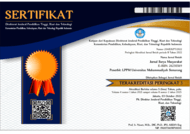Pelatihan Blended Learning Hypercontent with Hyperlink Menggunakan QR Code untuk Guru Sekolah Menengah Pertama sebagai Strategi Pembelajaran Matematika di Purwakarta
(1) Universitas Pendidikan Indonesia, Bandung
(2) Universitas Pendidikan Indonesia, Bandung
(3) Kementerian Agama, Purwakarta, Indonesia
(4) Universitas Pendidikan Indonesia, Bandung
(5) STKIP Pangeran Dharma Kusuma, Indramayu
(6) Universitas Pendidikan Indonesia, Bandung
(7) Universitas Pendidikan Indonesia, Bandung
(*) Corresponding Author
Abstract
As we all know that the Covid-19 pandemic has paralyzed various aspects including education. In the field of education, learning habits are limited face-to-face and are required to apply strict health protocols. On the other hand, the ability of teachers to teach their field of study using online methods still has limitations, for example, the ability to design teaching materials and transfer learning using media is considered to be very limited. Training and improving teacher competence through blended learning and the use of hyper content with hyperlinks are seen as one of the solutions so that teachers can design teaching materials oriented to text and image processing by using QR Codes. The subject matter, whether text, images, graphics, diagrams, or models designed by the teacher, can be delivered by using hyper content and inserting links to being content on the internet such as YouTube, to enhance the knowledge supply of teachers and students. The training activities were carried out face-to-face at the New Building, UPI Campus in Purwakarta, involving 20 Junior High School Teachers and 18 Madrasah Tsanawiyah Teachers in Purwakarta Regency. The results of the activity show that the blended learning hyper content with hyperlink training can improve the ability of teachers in designing engaging, interactive digital modules or teaching materials that are rich in content that can be accessed online anytime and anywhere or printed and then scanned via QR Code when students want to access the provided learning content. Thus, blended learning hyper content with hyperlinks can be used as an effective solution in improving the ability of teachers to design teaching materials during the COVID-19 pandemic and the implementation of limited face-to-face learning.
Keywords
Full Text:
PDFReferences
Bi, Y., Anderson, T., & Huang, M. (2013). Investigating the Relation between Student Engagement and Attainment in a Flexible Learning Environment. Proceedings of World Academy of Science, Engineering and Technology, 7(6), 1823–1827. https://doi.org/10.5281/zenodo.1329737
Fleck, B. K. B., Beckman, L. M., Sterns, J. L., & Hussey, H. D. (2014). YouTube in the Classroom: Helpful Tips and Student Perceptions. The Journal of Effective Teaching, 14(3), 21–37.
Huang, R., Chen, G., Yang, J., & Loewen, J. (2013). The New Shape of Learning: Adapting to Social Changes in the Information Society. In R. Huang, Kinshuk, & J. M. Spector (Eds.), Reshaping Learning (pp. 3–42). https://doi.org/10.1007/978-3-642-32301-0_1
Huda, S. N., Edhiya, N., Hemliah, & Lestari, S. A. (2013). Prototype Knowledge Management System Berbasis Omcollab. Prosiding SENTIA, 5(21–26). Retrieved from https://www.researchgate.net/profile/Sheila-Nurul-Huda/publication/302584394_PROTOTYPE_KNOWLEDGE_MANAGEMENT_SYSTEM_BERBASIS_OMCOLLAB/links/57319c1a08ae6cca19a2ce40/PROTOTYPE-KNOWLEDGE-MANAGEMENT-SYSTEM-BERBASIS-OMCOLLAB.pdf
Kemendikbud. (2020). Surat Edaran Tentang Pedoman Penyelenggaraan Belajar Dari Rumah Dalam Masa Darurat Penyebaran Corona Virus Disease (COVID-19). Indonesia.
National Council of Teachers of Mathematics. (2000). Principles Standards for School Mathematics. Retrieved from www.nctm.org
National Research Council. (2001). Adding It Up (J. Kilpatrick, J. Swafford, & B. Findell, Eds.). Retrieved from http://www.wakamono-up.jp/top/pdf/Third-party_evaluation_2013_points.pdf
Nurhayati, E., Nengsih, W., Rohaeti, E. E., & Herdiman, I. (2018). Pengembangan Bahan Ajar Materi Garis Istimewa pada Segitiga dengan Pendekatan Problem Posing berbantuan Geogebra. Jurnal Didaktik Matematika, 5(1), 54–65. https://doi.org/10.24815/jdm.v5i1.10073
Shaleha, K., & Yus, A. (2020). Peranan Bahan Ajar dalam Mengembangkan Bahasa Anak Usia Dini. Educatinal Journal of Elementary School, 1(3), 55–58. https://doi.org/http://dx.doi.org/10.30596%2Fejoes.v1i3.7220
Sistiarini, R. D., Ishaq, M., & Sulthoni. (2021). Kajian Konseptual PTM Terbatas dengan PJJ di Lembaga PAUD. Seminar Nasional Peta Jalan Pendidikan Dan Rancangan Undang-Undang Sistem Pendidikan Nasional, 1(1), 73–84. Retrieved from http://conference.um.ac.id/index.php/snpjp/article/view/1857/943
Stupel, M., & Ben-chaim, D. (2014). One Problem, Multiple Solutions: How Multiple Proofs can Connect Several Areas of Mathematics. Far East Journal of Mathematical Education, 11(2), 129–161. Retrieved from https://www.researchgate.net/profile/David-Ben-Chaim/publication/267438373_One_problem_multiple_solutions_how_multiple_proofs_can_connect_several_areas_of_mathematics/links/566d789e08ae62b05f0b1d9c/One-problem-multiple-solutions-how-multiple-proofs-can-co
Suketi, A. (2021). Upaya Meningkatkan Kreatifitas Guru TK Dalam Menyusun Bahan Ajar Melalui Pelatihan Kerja Kelompok Pada Masa Pandemi. Prosiding Seminar Nasional Manajemen Pendidikan, 2(1). Yogyakarta: Universitas Sarjanawiyata Tamansiswa.
Tambunan, W., Tampubolon, H., Sinaga, D., & Kailola, L. G. (2021). Pengaruh Covid-19 Terhadap Proses Pembelajaran Daring di Yayasan Pendidikan Cawan Bethel. Jurnal Comunita Servizio, 3(1), 561–566. https://doi.org/10.33541/cs.v3i1.2927
Turmudi, Hidayat, A. S., & Widodo, S. (2018). Pelatihan dan Pembinaan Lesson Studi dengan Pengenalan Fenomena Didaktis untuk Guru-guru Matematika SMP dan MTs di Purwakarta. Purwakarta: Laporan akhir Pelaksanaan PKM UPI Kampus Purwakarta.
Wang, L., & Zhang, Y. (2015). Advanced Image Retrieval Technology in Future Mobile Teaching and Learning. In Handbook of Mobile Teaching and Learning (pp. 835–846). https://doi.org/http://dx.doi.org/10.1007/978.3.642.41981.2_53.1
Widana, I. W., Sopandi, A. T., & Suwardika, G. (2021). Development of an Authentic Assessment Model in Mathematics Learning: A Science, Technology, Engineering, and Mathematics (STEM) Approach. Indonesian Research Journal in Education, 5(1), 192–209. Retrieved from https://online-journal.unja.ac.id/irje/article/view/12992
Widayanti. (2020). Blended Learning Hypercontent with Hyperlink. Purwakarta: Cipta Grafika.
Yuliyanto, A., Basit, R. A., Muqodas, I., Wulandari, H., & Amalia, D. M. (2020). Alternative Learning of The Future Based on Verbal-Linguistic, and Visual-Spatial Intelligence Through YouTube-Based Mind Map when Pandemic COVID-19. JPSD (Jurnal Pendidikan Sekolah Dasar), 7(2), 132–141. https://doi.org/http://dx.doi.org/10.12928/jpsd.v7i2.16925
Zulfa, S. (2021). The Implementation of Emergency Remote Teaching in the English Language during Covid-19 Pandemic (Jakarta: FITK UIN Syarif Hidayatullah Jakarta). Retrieved from https://repository.uinjkt.ac.id/dspace/bitstream/123456789/54727/1/Siti Zulfa_Full SKRIPSI_Watermark_FITK_PBI.pdf
Article Metrics
Abstract view : 645 timesPDF - 139 times
DOI: https://doi.org/10.26714/jsm.4.2.2022.219-229
Refbacks
- There are currently no refbacks.
Copyright (c) 2022 Jurnal Surya Masyarakat

Jurnal Surya Masyarakat (JSM) is licensed under Creative Commons Attribution-NonCommercial-NoDerivatives 4.0
------------------------------------------------------------------------------------------------------------------------
Jurnal Surya Masyarakat (JSM)
p-ISSN: 2623-0364; e-ISSN: 2623-0569
Published by: Lembaga Penelitian dan Pengabdian Masyarakat (LPPM) Universitas Muhammadiyah Semarang



.jpg)







.jpg)